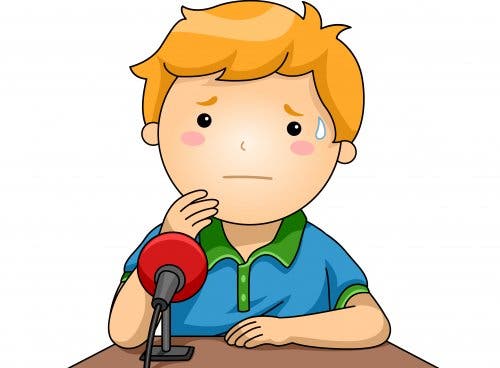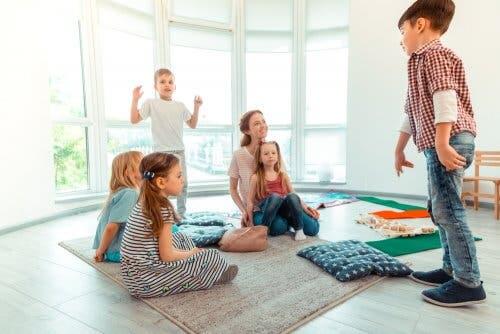How to Teach Public Speaking to Children


Written and verified by the pedagogue and trainer María Matilde
It’s important to teach public speaking to children, both at home as well as at school. That way, little ones get used to speaking in front of others and continue to develop this skill as they get older.
Today, we live in a digital world where we spend a great deal of time behind the “protection” of screens. But that doesn’t make public speaking any less important. In fact, it’s still a fundamental ability, necessary not only in informal everyday settings, but also in formal and professional contexts.
What is public speaking?
Many people have a hard time expressing themselves in front of a group of people, especially if they’re strangers. Fear, nervousness, and embarrassment about public speaking affect different systems in the body. As a result, people start to sweat, their heart rate goes up, their hands shake, their faces turn red, etc.
To overcome or control the fear and panic many people experience when they have to talk in public, it’s important to develop a series of skills. These skills are specific to public speaking, or the art of speaking eloquently in public.
In other words, public speaking doesn’t refer to the mere act of talking with others. Rather, it involves a series of techniques and roles that allow us to express ourselves more precisely.
Therefore, when we teach public speaking to children, the purpose is to help them be able to communicate in a more orderly fashion, with the objective of informing, persuading, or moving their audience.
Therefore, learning this skill allows children to master a variety of abilities in order to communicate clearly, directly, and confidently. And like any other art, public speaking is something that people must learn and practice in order for it to be natural.

Why is it important to teach public speaking to children?
As we’ve said, teaching public speaking to children is beneficial both for their development and their future. Not only will it benefit them in everyday situations, but also in the working world.
Learning public speaking as they grow allows them to put this skill into practice from a young age. In addition, it helps them overcome any fears they have recording standing up and talking in front of large groups of people.
It’s important for children to have these skills early on, so that they can express their ideas as they broaden their vocabulary. That way, they’ll feel more and more confident, believe in themselves, and gain self-esteem.
How to teach public speaking to children
There are many useful activities and resources that parents and teachers can use to help children gradually learn to speak in front of large groups of people. These include the following:
Skits and plays
This involves choosing a short story that children find attractive and having them act out the roles of different characters. That way, based on a script, kids will develop different dialogues, gain confidence, and dare to speak in front of an audience.
Recite poetry or short phrases
Poems and short phrases written by others or by the children themselves can also be useful. The objective is to encourage all of the students to read out loud to their classmates. Reciting in front of others can help children overcome any fear or shame they experience.
Defend and idea
When children have to present arguments to defend an idea, they must improvise and quickly decide on the right words and sentence structures. At home and at school, adults need to create a setting where children can give their opinions and express themselves verbally.
For example, by talking about issues like caring for the environment, what they want to be when they grow up, etc. Or you can simply discuss the reasons why it’s important to learn public speaking.
Pretend to sell a product or service
This can be a fun and interesting idea that allows kids to use their imagination and be creative. They’ll need to come up with original arguments and choose words and concepts that are convincing in order to attract and persuade their audience.

Recite tongue twisters
Reciting tongue twisters several days out of the week is a fun way for children to acquire more verbal fluidity. At the same time, they can improve their pronunciation. They can start with easy tongue twisters and gradually move on to more complex challenges.
Improve body posture and tone of voice
In all of the activities that children carry out, it’s important to remind them of the need to maintain good posture while speaking in public. Emphasize keeping their backs straight and avoiding sitting down or leaning on anything.
What’s more, we should point out the importance of keeping their heads up and being sure to look alternately at everyone in their audience. Also, when we teach public speaking to children, we can’t leave out things like using the right tone of voice. That means being firm and confident, while at the same time being friendly and pleasant. And, of course, not shouting.
Last of all, in order to teach public speaking to children…
Firstly, remember and emphasize that the main way to teach public speaking to children is to utilize play. Any sort of fun and creative activity where they can express themselves through play will help them find ways to overcome shyness and fear of embarrassment. That way, they’ll become better and better at communicating and speaking in front of others.
And, in second place, avoid speaking for children. Rather, encourage them to speak and answer for themselves. We should let them express their own ideas and opinions and listen to them attentively, without interruptions.
It’s important to teach public speaking to children, both at home as well as at school. That way, little ones get used to speaking in front of others and continue to develop this skill as they get older.
Today, we live in a digital world where we spend a great deal of time behind the “protection” of screens. But that doesn’t make public speaking any less important. In fact, it’s still a fundamental ability, necessary not only in informal everyday settings, but also in formal and professional contexts.
What is public speaking?
Many people have a hard time expressing themselves in front of a group of people, especially if they’re strangers. Fear, nervousness, and embarrassment about public speaking affect different systems in the body. As a result, people start to sweat, their heart rate goes up, their hands shake, their faces turn red, etc.
To overcome or control the fear and panic many people experience when they have to talk in public, it’s important to develop a series of skills. These skills are specific to public speaking, or the art of speaking eloquently in public.
In other words, public speaking doesn’t refer to the mere act of talking with others. Rather, it involves a series of techniques and roles that allow us to express ourselves more precisely.
Therefore, when we teach public speaking to children, the purpose is to help them be able to communicate in a more orderly fashion, with the objective of informing, persuading, or moving their audience.
Therefore, learning this skill allows children to master a variety of abilities in order to communicate clearly, directly, and confidently. And like any other art, public speaking is something that people must learn and practice in order for it to be natural.

Why is it important to teach public speaking to children?
As we’ve said, teaching public speaking to children is beneficial both for their development and their future. Not only will it benefit them in everyday situations, but also in the working world.
Learning public speaking as they grow allows them to put this skill into practice from a young age. In addition, it helps them overcome any fears they have recording standing up and talking in front of large groups of people.
It’s important for children to have these skills early on, so that they can express their ideas as they broaden their vocabulary. That way, they’ll feel more and more confident, believe in themselves, and gain self-esteem.
How to teach public speaking to children
There are many useful activities and resources that parents and teachers can use to help children gradually learn to speak in front of large groups of people. These include the following:
Skits and plays
This involves choosing a short story that children find attractive and having them act out the roles of different characters. That way, based on a script, kids will develop different dialogues, gain confidence, and dare to speak in front of an audience.
Recite poetry or short phrases
Poems and short phrases written by others or by the children themselves can also be useful. The objective is to encourage all of the students to read out loud to their classmates. Reciting in front of others can help children overcome any fear or shame they experience.
Defend and idea
When children have to present arguments to defend an idea, they must improvise and quickly decide on the right words and sentence structures. At home and at school, adults need to create a setting where children can give their opinions and express themselves verbally.
For example, by talking about issues like caring for the environment, what they want to be when they grow up, etc. Or you can simply discuss the reasons why it’s important to learn public speaking.
Pretend to sell a product or service
This can be a fun and interesting idea that allows kids to use their imagination and be creative. They’ll need to come up with original arguments and choose words and concepts that are convincing in order to attract and persuade their audience.

Recite tongue twisters
Reciting tongue twisters several days out of the week is a fun way for children to acquire more verbal fluidity. At the same time, they can improve their pronunciation. They can start with easy tongue twisters and gradually move on to more complex challenges.
Improve body posture and tone of voice
In all of the activities that children carry out, it’s important to remind them of the need to maintain good posture while speaking in public. Emphasize keeping their backs straight and avoiding sitting down or leaning on anything.
What’s more, we should point out the importance of keeping their heads up and being sure to look alternately at everyone in their audience. Also, when we teach public speaking to children, we can’t leave out things like using the right tone of voice. That means being firm and confident, while at the same time being friendly and pleasant. And, of course, not shouting.
Last of all, in order to teach public speaking to children…
Firstly, remember and emphasize that the main way to teach public speaking to children is to utilize play. Any sort of fun and creative activity where they can express themselves through play will help them find ways to overcome shyness and fear of embarrassment. That way, they’ll become better and better at communicating and speaking in front of others.
And, in second place, avoid speaking for children. Rather, encourage them to speak and answer for themselves. We should let them express their own ideas and opinions and listen to them attentively, without interruptions.
All cited sources were thoroughly reviewed by our team to ensure their quality, reliability, currency, and validity. The bibliography of this article was considered reliable and of academic or scientific accuracy.
- Blaschke, J. y Pons, P. P. (2003). El arte de hablar en público. Ediciones Robinbook. Recuperado de https://books.google.es/books?hl=es&lr=&id=MTcaBqCzSYoC&oi=fnd&pg=PA11&dq=oratoria+hablar+en+p%C3%BAblico&ots=vjpHChQLam&sig=XC9wLN_oD-0seVAboALqbuAN1NM#v=onepage&q=oratoria%20hablar%20en%20p%C3%BAblico&f=false
- Alban Alencar, A. (2005). Oratoria: el arte de hablar en público. Ediciones Marketing Mix. Lima Perú.
- Sánchez Prieto, G. A. (2015). Educar en la palabra: manual de técnicas de debate, oratoria y argumentación. Editorial Blu. Madrid España. Recuperado de https://repositorio.comillas.edu/xmlui/bitstream/handle/11531/13515/EEP.pdf?sequence=1&isAllowed=y
This text is provided for informational purposes only and does not replace consultation with a professional. If in doubt, consult your specialist.








